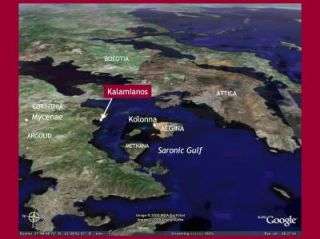FSU classics professor exploring a 'lost' city of the Mycenaeans

Along an isolated, rocky stretch of Greek shoreline, a Florida State University researcher and his students are unlocking the secrets of a partially submerged, “lost” harbor town believed to have been built by the ancient Mycenaeans nearly 3,500 years ago.
“This is really a remarkable find,” said Professor Daniel J. Pullen, chairman of FSU’s Department of Classics. “It is rare indeed to locate an entire town built during the Late Bronze Age that shows this level of preservation.”
Pullen and a colleague, Assistant Professor of Classical Studies Thomas F. Tartaron of the University of Pennsylvania, led students from both universities in conducting an initial study of the site during May and June of 2007. What they found was unique: an archaeological site that required very little digging.
“Because of soil erosion and tectonic subsidence” -- the latter induced by earthquakes along the numerous local faults -- “much of the soil had already been stripped from the site,” Pullen said. “So the architectural remains of about 20 acres of closely built structures were plainly visible.”
Although more than three millennia of earthquakes and other factors have collapsed the structures, what remains are the buildings’ foundations, walls that in some places still stand nearly 5 feet tall, and a number of clues as to the settlement’s construction and purpose.
“All of the structures were laid out in a grid pattern, which suggests that the entire community was planned and then built all at once, rather than piecemeal,” Pullen said. “This would indicate that the settlement was built with some strategic purpose -- perhaps as a military or naval outpost.”
The settlement, referred to as Korphos-Kalamianos by Pullen and Tartaron, rests on the shores of the Saronic Gulf in the western Aegean Sea about 60 miles to the southwest of the Greek capital, Athens. Directly across the gulf, the ancient city-state of Kolonna on Aigina likely was a rival of the emerging city-state of Mycenae, which sits about 40 miles inland to the west, during the period between 1400 and 1200 B.C. when Korphos-Kalamianos was built.
“We have identified some fortification walls with gates on the inland side of Korphos-Kalamianos, which does suggest that the town had at least some role as a fortress, possibly to protect the harbor,” Pullen said.
Pullen and Tartaron’s 2007 work involved conducting a systematic study of the architectural remains at Korphos-Kalamianos and producing an accurate map of their location using Global Positioning System and other high-tech instruments. This summer, they plan to return to the site with more students (five FSU graduate students and two alumni will make the trip) to conduct underwater research along the shoreline.
“We don’t know exactly why, but some portion of the settlement is now submerged in the Saronic Gulf,” Pullen said. “We can say that in the Bronze Age the configuration of the coastline at Kalamianos was very different from that of today. So this summer, we plan to collaborate with Greece’s department of underwater antiquities on a bathymetric survey of the shallow waters around the Korphos region that should clarify aspects of the Bronze Age coastline.” (Bathymetry is the measurement of the depths of oceans, seas or other large bodies of water.)
To learn more about the project, visit .
Source: Florida State University




















